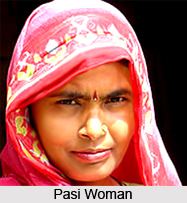 | ||
The Pasi were one of the untouchable communities (or dalits) who are now classified as a Scheduled Caste under modern India's system of positive discrimination. As untouchables, they were traditionally considered outside the Hindu ritual ranking system of castes known as varna.
Contents
They live in the northern Indian states of Bihar and Uttar Pradesh.
Present circumstances
The Pasi live mainly in the northern Indian states of Bihar and Uttar Pradesh, where their traditional occupation was that of rearing pigs. As of the 2001 Census of India, the Pasi are the second-largest Dalit group in Uttar Pradesh, where they constituted 16 per cent of the Dalit population and were mostly recorded in the Awadh region. The 2011 Census of India for the state recorded their population as 6,522,166. That figure included the Tarmali.
Chandra Bhan Prasad, a journalist and adviser to dalit organisations, recalls how those who continued pig-rearing were ill-treated by socio-political activists of their community, who blamed the occupation in large part for their untouchable status "and not the Caste Order or the systems of Brahmanism". Threats of ostracism would be issued and, at least in his village, the tradition of pig-rearing eventually stopped. The People of India, compiled by the Anthropological Survey of India, describes them as a community of small peasant farmers, many of whom have started to migrate to cities, and are now engaged in businesses, private and government service and industrial labour.
According to the historian Ramnarayan Rawat, the role of the Uttar Pradesh Pasi community in the Kisan Sabha (Peasant Association) movement of 1919-1922 has been understated by earlier writers, such as Jawaharlal Nehru and Gyanendra Pandey. Rawat argues that these earlier historians have an Indian nationalist viewpoint that tended to disdain the contribution of Dalit communities in the struggle against colonial rule. Whereas his predecessors at best documented a minimal and late-arriving Pasi involvement in the movement — and one that was inclined to criminal behaviour, such as rioting, rather than political activism — Rawat believes that the Pasi and Chamar untouchable groups were significant from the outset and their motivations were similar to the other agricultural caste communities that were involved in it. In his recasting of the nationalist perspective that, according to him, downplays the significance of Dalits in Indian history, Rawat says that the Pasis who were involved in the Kisan Sabha were in fact land-occupiers and had the same concerns as other groups of that type, rather than being the landless labourers that his predecessors had assumed.
In Bihar, the Pasi are also known as the Chaudhary. The community were traditionally connected with toddy tapping. They are found throughout Bihar, and speak the Magadhi dialect of Hindi. They have four sub-divisions, namely the Tirsulia, Gaiduha, Kamani and Byadha. In addition to toddy tapping, the community now are also involved in a number of activities such as petty business.
Invention of tradition
The Pasi have in recent times engaged in invention of tradition. Badri Narayan, a social historian and cultural anthropologist, says that
Sources of vision and contemplation are absent without literature. This feeling, along with the growing urge to construct an assertive identity and the sense of being deprived of history, led the Pasi community towards the invention of heroes, histories and myths and their documentation in the print medium.
